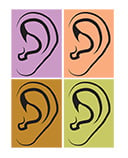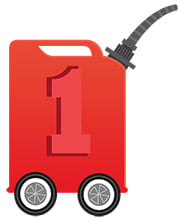 Consumers are beginning to use 3-D printers to make everything from clothing to plastic toys. Now BME alumnus Lawrence Bonassar ’89 has co-authored research in Bioscience Technology showing that it is possible to use that technology, plus living cells, to create a replacement human ear. An associate professor and associate chair in both biomedical and mechanical engineering at Cornell University, Bonassar described how the 3-D printer, using an image of a child’s ear taken by a 3-D camera, produced a soft mold of the appendage. That mold then was injected with a collagen gel infused with cartilage-producing cow cells. Several weeks later, cartilage had replaced the collagen. According to Bonassar, this is an important first step to one day growing customized ears for children and adults.
Consumers are beginning to use 3-D printers to make everything from clothing to plastic toys. Now BME alumnus Lawrence Bonassar ’89 has co-authored research in Bioscience Technology showing that it is possible to use that technology, plus living cells, to create a replacement human ear. An associate professor and associate chair in both biomedical and mechanical engineering at Cornell University, Bonassar described how the 3-D printer, using an image of a child’s ear taken by a 3-D camera, produced a soft mold of the appendage. That mold then was injected with a collagen gel infused with cartilage-producing cow cells. Several weeks later, cartilage had replaced the collagen. According to Bonassar, this is an important first step to one day growing customized ears for children and adults.
Along with their rifles and radios, soldiers soon may carry palm-size lasers. No more powerful than a classroom pointer, these beams could be aimed at a tiny remote device that would—in a process inspired by the Japanese art of paper-folding called origami— fold itself into an apparatus that could perform a variety of military tasks, from switching on sensors to detonating explosives Kate Laflin, a doctoral student in the lab of David Gracias, Department of Chemical and Biomolecular Engineering, is lead author of a recent paper in Applied Physics Letters on this work, which researchers at Hopkins and the U.S. Army Research Laboratory believe could one day make possible the development of a multitool for soldiers based on an idea called programmable matter

Having trouble keeping track of all your inspired ideas, notes, and “to dos” throughout the day? Now there’s an app for that, thanks to Andreas Schobel ’03. Schobel is CEO and co-founder of Catch.com, a San Francisco–based leader in creating mobile applications aimed at helping people turn their ideas into action. His company’s app, called “Catch,” has a cool “capture wheel” that lets users easily create a new text, photo, or voice note. Lists can be kept private or easily shared with others, fostering collaboration. The app is free and available for Android or iPhone

Rami Bedewi ’16 must laugh when he watches TV commercials bragging about vehicles getting 30 miles per gallon. Bedewi—a mechanical engineering major—traveled last fall from the outskirts of New York City to the nation’s capital (about 230 miles) on little more than a single gallon of gas. His vehicle? A one-seat, three-wheeled car he designed and built during his senior year at Georgetown Preparatory School. Bedewi engineered the little vehicle so the electric motor powered its wheels while its gasoline engine recharged the battery. Traveling mostly back roads at 30 to 45 mph, Bedewi’s “One Gallon Challenge” took 12 hours.
On a typical spacecraft, the high level of ambient noise makes it tough for doctors to record crew members’ heart sounds using a typical stethoscope. Now a team of mechanical engineering students working under James West and Nathan Scott have designed a special “space stethoscope” that overcomes these issues by using a new, large area electret microphone and some clever signal processing. The device is sensitive enough to pick up body sounds even if not placed perfectly on the patient’s body. In addition, it features rechargeable batteries, low consumption of power, mechanical exclusion of ambient noise, and a suction cup that helps it stick to the patient’s chest.




